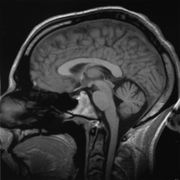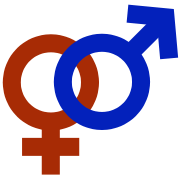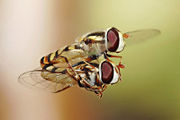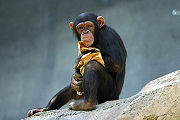Gender
2008/9 Schools Wikipedia Selection. Related subjects: Culture and Diversity
Gender refers to the differences between men and women. Encyclopædia Britannica notes that gender identity is "an individual's self-conception as being male or female, as distinguished from actual biological sex." Although gender is commonly used interchangeably with sex, within the social sciences it often refers to specifically social differences, known as gender roles in the biological sciences. Historically, feminism has posited that many gender roles are socially constructed, and lack a clear biological explanation. People whose gender identity feels incongruent with their physical bodies may call themselves transgender or genderqueer.
Many languages have a system of grammatical gender, a type of noun class system — nouns may be classified as masculine or feminine (for example Spanish, Hebrew, Arabic and French) and may also have a neuter grammatical gender (for example Sanskrit, German, Polish, and the Scandinavian languages). In such languages, this is essentially a convention, which may have little or no connection to the meaning of the words. Likewise, a wide variety of phenomena have characteristics termed gender, by analogy with male and female bodies (such as the gender of connectors and fasteners) or due to societal norms.
Etymology and usage
The word gender in English
As kind
The word gender comes from the Middle English gendre, a loanword from Norman-conquest-era Old French. This, in turn, came from Latin la:genus. Both words mean 'kind', 'type', or 'sort'. They derive ultimately from a widely attested Proto-Indo-European (PIE) root gen-, which is also the source of kin, kind, king, and many other English words. It appears in Modern French in the word genre (type, kind, also fr:genre sexuel) and is related to the Greek root gen- (to produce), appearing in gene, genesis, and oxygen. As a verb, it means breed in the King James Bible:
- 1616: Thou shalt not let thy cattle gender with a diverse kind — Leviticus 19:19.
Most uses of the root gen in Indo-European languages refer either directly to what pertains to birth or, by extension, to natural, innate qualities and their consequent social distinctions (for example gentry, generation, gentile, genocide and eugenics). The first edition of the Oxford English Dictionary (OED1, Volume 4, 1900) notes the original meaning of gender as 'kind' had already become obsolete.
- Gender (dʒe'ndəɹ), sb. Also 4 gendre. [a. OF. gen(d)re (F. genre) = Sp. género, Pg. gênero, It. genere, ad. L. gener- stem form of genus race, kind = Gr. γένος, Skr. jánas:— OAryan *genes-, f. root γεν- to produce; cf. KIN.]
- †1. Kind, sort, class; also, genus as opposed to species. The general gender: the common sort (of people). Obs.
- 13.. E.E.Allit. P. P. 434 Alle gendrez so ioyst wern ioyned wyth-inne. c 1384 CHAUSER H. Fame* 1. 18 To knowe of hir signifiaunce The gendres. 1398 TREVISA Barth. De P. K. VIII. xxix. (1495) 34I Byshynynge and lyghte ben dyuers as species and gendre, for suery shinyng is lyght, but not ayenwarde. 1602 SHAKES. Ham. IV. vii. 18 The great loue the generall gender beare him. 1604 — Oth. I. iii. 326 Supplie it with one gender of Hearbes, or distract it with many. 1643 and so on.
As masculinity or femininity
The use of gender to refer to masculinity and femininity as types is attested throughout the history of Modern English (from about the 14th century).
- 1387-8: No mo genders been there but masculine, and femynyne, all the remnaunte been no genders but of grace, in facultie of grammar — Thomas Usk, The Testament of Love II iii ( Walter William Skeat) 13.
- c. 1460: Has thou oght written there of the femynyn gendere? — Towneley Mystery Plays xxx 161 Act One.
- 1632: Here's a woman! The soul of Hercules has got into her. She has a spirit, is more masculine Than the first gender — Shackerley Marmion, Holland's Leaguer III iv.
- 1658: The Psyche, or soul, of Tiresias is of the masculine gender — Thomas Browne, Hydriotaphia.
- 1709: Of the fair sex ... my only consolation for being of that gender has been the assurance it gave me of never being married to any one among them — Mary Wortley Montagu, Letters to Mrs Wortley lxvi 108.
- 1768: I may add the gender too of the person I am to govern — Laurence Sterne, A Sentimental Journey Through France and Italy.
- 1859: Black divinities of the feminine gender — Charles Dickens, A Tale of Two Cities.
- 1874: It is exactly as if there were a sex in mountains, and their contours and curves and complexions were here all of the feminine gender — Henry James, 'A Chain of Italian Cities', The Atlantic Monthly 33 (February, p. 162.)
- 1892: She was uncertain as to his gender — Robert Grant, 'Reflections of a Married Man', Scribner's Magazine 11 (March, p. 376.)
- 1896: As to one's success in the work one does, surely that is not a question of gender either — Daily News 17 July.
- c. 1900: Our most lively impression is that the sun is there assumed to be of the feminine gender — Henry James, Essays on Literature.
As a grammatical term
According to Aristotle, the Greek philosopher Protagoras used the terms "masculine", "feminine", and "neuter" to classify nouns, introducing the concept of grammatical gender.
- τὰ γένη τῶν ὀνομάτων ἄρρενα καὶ θήλεα καὶ σκεύη
- The classes (genē) of the nouns are males, females and things.
- — Aristotle, The Technique of Rhetoric III v
- The classes (genē) of the nouns are males, females and things.
The words for this concept are not related to gen- in all Indo-European languages (for example, rod in Slavic languages).
The usage of gender in the context of grammatical distinctions is a specific and technical usage. However, in English, the word became attested more widely in the context of grammar, than in making sexual distinctions.
This was noted in OED1, prompting Henry Watson Fowler to recommend this usage as the primary and preferable meaning of gender in English. "Gender...is a grammatical term only. To talk of persons...of the masculine or feminine g[ender], meaning of the male or female sex, is either a jocularity (permissible or not according to context) or a blunder."
The sense of this can be felt by analogy with a modern expression like "persons of the female persuasion." It should be noted, however, that this was a recommendation, neither the Daily News nor Henry James citations (above) are "jocular" nor "blunders." Additionally, patterns of usage of gender have substantially changed since Fowler's day (noun class above, and sexual stereotype below).
As a sexual stereotype
The word sex is sometimes used in the context of social roles of men and women — for example, the British Sex Disqualification (Removal) Act 1919 that ended exclusion of women from various official positions. Such usage was more common before the 1970s, over the course of which the feminist movement took the word gender into their own usage to describe their theory of human nature. Early in that decade, gender was used in ways consistent with both the history of English and the history of attestation of the root. However, by the end of the decade consensus was achieved among feminists regarding this theory and its terminology. The theory was that human nature is essentially epicene and social distinctions based on sex are arbitrarily constructed. Matters pertaining to this theoretical process of social construction were labelled matters of gender.
- 1998: Today a return to separate single-sex schools may hasten the revival of separate gender roles. — Wendy Kaminer, 'The Trouble with Single-Sex Schools', The Atlantic Monthly (April).
The American Heritage Dictionary uses the following two sentences to illustrate the difference, noting that the distinction "is useful in principle, but it is by no means widely observed, and considerable variation in usage occurs at all levels."
- 2000: The effectiveness of the medication appears to depend on the sex (not gender) of the patient.
- 2000: In peasant societies, gender (not sex) roles are likely to be more clearly defined.
In the last two decades of the 20th century, the use of gender in academia increased greatly, outnumbering uses of sex in the social sciences. Frequently, but not exclusively, this indicates acceptance of the feminist theory of human nature. However, in many instances, the term gender still refers to sexual distinction generally without such an assumption.
- 2004: Among the reasons that working scientists have given me for choosing gender rather than sex in biological contexts are desires to signal sympathy with feminist goals, to use a more academic term, or to avoid the connotation of copulation — David Haig, The Inexorable Rise of Gender and the Decline of Sex.
In fact, the ideological distinction between sex and gender is only fitfully observed.
The concept of gender in other languages
Greek (distinguishes biological from sociological in adjectives)
In Greek, male biology and masculine grammatical inflection are denoted by arsenikos (αρσενικός), in distinction to sociological masculinity, which is denoted by andrikos (ανδρικός). Likewise, female biology and feminine grammatical inflection are denoted by thēlukos ( θηλυκός); and sociological femininity is denoted by gunaikeios ( γυναικείος, compare English gynaecology). This distinction is at least as old as Aristotle (see above). It is a different distinction to English, where 'male' and 'female' refer to animals as well as humans, but not to grammatical categories; however, 'masculine' and 'feminine' refer to grammatical categories as well as humans, but not properly to animals, except as anthropomorphism.
German and Dutch (no distinction in nouns — Geschlecht and geslacht)
In English, both 'sex' and 'gender' can be used in contexts where they could not be substituted — 'sexual intercourse', 'safe sex', 'sex worker', or on the other hand, 'grammatical gender'. Other languages, like German or Dutch, use the same word, de:Geschlecht or nl:geslacht, to refer not only to biological sex, but social differences as well, making a distinction between biological 'sex' and 'gender' identity difficult. In some contexts, German has adopted the English loanword Gender to achieve this distinction. Sometimes Geschlechtsidentität is used for 'gender' (although it literally means 'gender identity') and Geschlecht for 'sex'. More common is the use of modifiers: biologisches Geschlecht for 'biological sex', Geschlechtsidentität for 'gender identity' and Geschlechtsrolle for 'gender role', and so on. Both German and Dutch use a separate word, de:Genus, for grammatical gender.
Swedish (clear distinction in nouns — genus and kön)
In Swedish, 'gender' is translated with the linguistically cognate sv:genus, including sociological contexts, thus: Genusstudier (gender studies) and Genusvetenskap (gender science). 'Sex' in Swedish, however, only signifies sexual relations, and not the proposed English dichotomy, a concept for which sv:kön (also from PIE gen-) is used. A common distinction is then made between kön (sex) and genus (gender), where the former refers only to biological sex. However, Swedish uses the words sv:könsroll and sv:könsidentitet (literally 'sex role' and 'sex-identity') for the English terms 'gender role' and 'gender identity'.
French (sexe and genre)
In French, the word sexe is most widely used for both "sex" and "gender" in everyday contexts. However, the word genre is increasingly used to refer to gender in queer or academic contexts, such as the word transgenre ( transgender) or the translation of Judith Butler's book Gender Trouble, Trouble dans le genre. The term identité sexuelle was proposed for "gender" or "gender identity," although it can be confused with "sexual identity" (one's identity as it relates to one's sexual life).
Summary
The historical meaning of gender is something like "things we treat differently because of their inherent differences". It has three common applications in contemporary English. Most commonly it is applied to the general differences between men and women, without any assumptions regarding biology or sociology. Sometimes however, the usage is technical or assumes a particular theory of human nature, this is always clear from the context. Finally the same word, gender, is also commonly applied to the independent concept of distinctive word categories in certain languages. Grammatical gender has little or nothing to do with differences between men and women.
Biology of gender
The biology of gender became the subject of an expanding number of studies over the course of the late 20th century. One of the earliest areas of interest was what is now called gender identity disorder (GID). Studies in this, and related areas, inform the following summary of the subject by John Money, a pioneer and controversial sex and gender researcher.
| “ | The term "gender role" appeared in print first in 1955. The term "gender identity" was used in a press release, November 21, 1966, to announce the new clinic for transsexuals at The Johns Hopkins Hospital. It was disseminated in the media worldwide, and soon entered the vernacular. The definitions of gender and gender identity vary on a doctrinal basis. In popularized and scientifically debased usage, sex is what you are biologically; gender is what you become socially; gender identity is your own sense or conviction of maleness or femaleness; and gender role is the cultural stereotype of what is masculine and feminine. Causality with respect to gender identity disorder is subdivisible into genetic, prenatal hormonal, postnatal social, and postpubertal hormonal determinants, but there is, as yet, no comprehensive and detailed theory of causality. Gender coding in the brain is bipolar. In gender identity disorder, there is discordancy between the natal sex of one's external genitalia and the brain coding of one's gender as masculine or feminine. | ” |
Money refers to attempts to distinguish a difference between biological sex and social gender as "scientifically debased", because of our increased knowledge of a continuum of dimorphic features (Money's word is "dipolar"), that link biological and behavioural differences. These extend from the exclusively biological "genetic" and "prenatal hormonal" differences between men and women, to postnatal features, some of which are social, but others have been shown to result from "postpubertal hormonal" effects.
Prior to recent technology that made study of brain differences possible, observable differences in behaviour between men and women could not be adequately explained solely on the basis of the limited observable physical differences between them. Hence the, then plausible, theory that these differences might be explained by arbitrary cultural assignments of roles. However, Money notes concisely that masculine or feminine self-identity is now seen as essentially an expression of dimorphic brain structure (Money's word is "coding"). The new discoveries have an additional advantage over the theory of cultural arbitrariness of gender roles, as they help explain the similarities between these roles in widely divergent cultures (see Steven Pinker on Donald Brown's Human Universals, including romantic love, sexual jealousy, and patriarchy).
Although causation from the biological — genetic and hormonal — to the behavioural has been broadly demonstrated and accepted, Money is careful to also note that understanding of the causal chains from biology to behaviour in sex and gender issues is very far from complete. For example, we have not conclusively identified a " gay gene", but nor have we excluded such a possibility.
The following systematic list ( gender taxonomy) illustrates the kinds of diversity that have been studied and reported in medical literature. It is placed in roughly chronological order of biological and social development in the human life cycle. The earlier stages are more purely biological and the latter are more dominantly social. Causation is known to operate from chromosome to gonads, and from gonads to hormones. It is also significant from brain structure to gender identity (see Money quote above). Brain structure and processing (biological) that may explain erotic preference (social), however, is an area of ongoing research. Terminology in some areas changes quite rapidly to accommodate the constantly growing knowledge base. One journal, published since 2002, is specifically devoted to Genes, Brains and Behaviour. An interactive, animated display of early development is available online.
Gender taxonomy
- chromosomes: 46xx, 46xy, 47xxy ( Klinefelter's syndrome), 45xo ( Turner's syndrome), 47xyy, 47xxx, 48xxyy, 46xx/xy mosaic, other mosaic, and others
- gonads: testicles, ovaries, one of each ( hermaphrodites), ovotestes, or other gonadal dysgenesis
- hormones: androgens including testosterone; estrogens — including estradiol, estriol, estrone; antiandrogens and others
- genitals: primary sexual characteristics, see diagram for the "six class system"
- secondary sexual characteristics: dimorphic physical characteristics, other than primary characteristics (most prominently breasts or their absence)
- brain structure: special kinds of secondary characteristics, due to their influence on psychology and behaviour
- gender identity: psychological identification with either of the two main sexes
- gender role: social conformity with expectations for either of the two main sexes
- erotic preference: gynophilia, androphilia, bisexuality, asexuality and various paraphilias.
Sex
Sexual reproduction
- Sexual differentiation demands the fusion of gametes which are morphologically different. — Cyril Dean Darlington, Recent Advances in Cytology, 1937.
Sexual reproduction is a common method of producing a new individual within various species. In sexually reproducing species, individuals produce special kinds of cells (called gametes) whose function is specifically to fuse with one unlike gamete and thereby to form a new individual. This fusion of two unlike gametes is called fertilization. By convention, where one type of gamete cell is physically larger than the other, it is associated with female sex. Thus an individual that produces exclusively large gametes ( ova in humans) is said to be female, and one that produces exclusively small gametes ( spermatozoa in humans) is said to be male.
An individual that produces both types of gametes is called hermaphrodite (a name applicable also to people with one testis and one ovary). In some species hermaphrodites can self-fertilize (see Selfing), in others they can achieve fertilization with females, males or both. Some species, like the Japanese Ash, Fraxinus lanuginosa, only have males and hermaphrodites, a rare reproductive system called androdioecy. Gynodioecy is also found in several species. Human hermaphrodites are typically, but not always, infertile.
What is considered defining of sexual reproduction is the difference between the gametes and the binary nature of fertilization. Multiplicity of gamete types within a species would still be considered a form of sexual reproduction. However, of more than 1.5 million living species, recorded up to about the year 2000, "no third sex cell — and so no third sex — has appeared in multicellular animals." Why sexual reproduction has an exclusively binary gamete system is not yet known. A few rare species that push the boundaries of the definitions are the subject of active research for light they may shed on the mechanisms of the evolution of sex. For example, the most toxic insect, the harvester ant Pogonomyrmex, has two kinds of female and two kinds of male. One hypothesis is that the species is a hybrid, evolved from two closely related preceding species.
Fossil records indicate that sexual reproduction has been occurring for at least one billion years. However, the reason for the initial evolution of sex, and the reason it has survived to the present are still matters of debate, there are many plausible theories. It appears that the ability to reproduce sexually has evolved independently in various species on many occasions. There are cases where it has also been lost. The flatworm, Dugesia tigrina, and a few other species can reproduce either sexually or asexually depending on various conditions.
Sexual differentiation

Although sexual reproduction is defined at the cellular level, key features of sexual reproduction operate within the structures of the gamete cells themselves. Notably, gametes carry very long molecules called DNA that the biological processes of reproduction can "read" like a book of instructions. In fact, there are typically many of these "books", called chromosomes. Human gametes usually have 23 chromosomes, 22 of which are common to both sexes. The final chromosomes in the two human gametes are called sex chromosomes because of their role in sex determination. Ova always have the same sex chromosome, labelled X. About half of spermatozoa also have this same X chromosome, the rest have a Y chromosome. At fertilization the gametes fuse to form a cell, usually with 46 chromosomes, and either XX female or XY male, depending on whether the sperm carried an X or a Y chromosome. Some of the other possibilities are listed above.
In humans, the " default" processes of reproduction result in an individual with female characteristics. An intact Y chromosome contains what is needed to "reprogram" the processes sufficiently to produce male characteristics, leading to sexual differentiation (see also Sexual dimorphism). Part of the Y chromosome, the Sex-determining Region Y (SRY), causes what would normally become ovaries to become testes. These, in turn, produce male hormones called androgens. However, several points in the processes have been identified where variations can result in people with atypical characteristics, including atypical sexual characteristics. Terminology for atypical sexual characteristics has not stabilized. Disorder of sexual development (DSD) is used by some in preference to intersex, which is used by others in preference to pseudohermaphroditism.
Androgen insensitivity syndrome (AIS) is an example of a DSD that also illustrates that female development is the default for humans. Although having one X and one Y chromosome, some people are biologically insensitive to the androgens produced by their testes. As a result they follow the normal human processes which result in a person of female sex. Women who are XY report identifying as a woman — feeling and thinking like a woman — and, where their biology is completely insensitive to masculinizing factors, externally they look identical to other women. Unlike other women, however, they cannot produce ova, because they do not have ovaries.
The human XY system is not the only sex determination system. Birds typically have a reverse, ZW system — males are ZZ and females ZW. Whether male or female birds influence the sex of offspring is not known for all species. Several species of butterfly are known to have female parent sex determination. The platypus has a complex hybrid system, the male has ten sex chromosomes, half X and half Y.
Genes, Brains and Behaviour
Genes
Chromosomes were likened to books (above), also like books they have been studied at more detailed levels. They contain "sentences" called genes. In fact, many of these sentences are common to multiple species. Sometimes they are organized in the same order, other times they have been "edited" — deleted, copied, changed, moved, even relocated to another "book", as species evolve. Genes are a particularly important part of understanding biological processes because they are directly associated with observable objects, outside chromosomes, called proteins, whose influence on cell chemistry can be measured. In some cases genes can also be directly associated with differences clear to the naked eye, like eye-colour itself. Some of these differences are sex specific, like hairy ears. The "hairy ear" gene is on the Y chromosome which is why only men have it. However, sex-limited genes on any chromosome can "say" for example, "if you are in a male body do X, otherwise do not." The same principle explains why chimpanzees and humans are distinct, despite sharing nearly all their genes.
The study of genetics is particularly inter-disciplinary. It is relevant to almost every biological science. It is investigated in detail by molecular level sciences, and itself contributes details to high level abstractions like evolutionary theory.
Brain

"It is well established that men have a larger cerebrum than women by about 8–10% (Filipek et al., 1994; Nopoulos et al., 2000; Passe et al., 1997a,b; Rabinowicz et al., 1999; Witelson et al., 1995)." However, what is functionally relevant are differences in composition and "wiring", some of these differences are very pronounced. Richard J. Haier and colleagues at the universities of New Mexico and California (Irvine) found, using brain mapping, that men have more than six times the amount of grey matter related to general intelligence than women, and women have nearly ten times the amount of white matter related to intelligence than men.
Gray matter is used for information processing, while white matter consists of the connections between processing centers. Other differences are measurable but less pronounced. Most of these differences are known to be produced by the activity of hormones, hence ultimately derived from the Y chromosome and sexual differentiation. However, differences arising from the activity of genes directly have also been observed.
| “ | A sexual dimorphism in levels of expression in brain tissue was observed by quantitative real-time PCR, with females presenting an up to 2-fold excess in the abundance of PCDH11X transcripts. We relate these findings to sexually dimorphic traits in the human brain. Interestingly, PCDH11X/Y gene pair is unique to Homo sapiens, since the X-linked gene was transposed to the Y chromosome after the human–chimpanzee lineages split. | ” |

It has also been demonstrated that brain processing responds to the external environment. Learning, both of ideas and behaviours, appears to be coded in brain processes. It also appears that in several simplified cases this coding operates differently, but in some ways equivalently, in the brains of men and women. For example, both men and women learn and use language; however, bio-chemically, they appear to process it differently. Differences in male and female use of language are likely reflections both of biological preferences and aptitudes, and of learned patterns.
Two of the main fields that study brain structure, biological (and other causes) and behavioural (and other results) are brain neurology and biological psychology. Cognitive science is another important discipline in the field of brain research.
Behaviour
Some behaviours are so simple that biological explanation may be sufficient. Blinking, yawning and stretching are more reflexes than behaviours. However, etiquette and protocol are complicated behaviours, presumably influenced by many environmental factors, including social (man-made) ones. A large area of research in behavioural psychology collates evidence in an effort to discover correlations between behaviour and various possible antecedents such as genetics, culture, gender, physical or social development, or physical or social environments.
A core research area within sociology is the way human behaviour operates on itself, in other words, how the behaviour of one group or individual influences the behaviour of other groups or individuals. Starting in the late 20th century, the feminist movement has contributed extensive study of gender and theories about it, notably within sociology but not restricted to it.
Social categories
Sociology
Sexologist John Money coined the term gender role in 1955. "The term gender role is used to signify all those things that a person says or does to disclose himself or herself as having the status of boy or man, girl or woman, respectively. It includes, but is not restricted to, sexuality in the sense of eroticism." Elements of such a role include clothing, speech patterns, movement, occupations, and other factors not limited to biological sex. Because social aspects of gender can normally be presumed to be the ones of interest in sociology and closely related disciplines, gender role is often abbreviated to gender in their literature, without leading to ambiguity in that context.
Most societies have only two distinct, broad classes of gender roles — male and female — and these correspond with biological sex. However, some societies explicitly incorporate people who adopt the gender role opposite to their biological sex, for example the Two-Spirit people of some indigenous American peoples. Other societies include well-developed roles that are explicitly considered more or less distinct from archetypal male and female roles in those societies. In the language of the sociology of gender they comprise a third gender, more or less distinct from biological sex (sometimes the basis for the role does include intersexuality or incorporates eunuchs). One such gender role is that adopted by the hijras of India and Pakistan.

The Bugis people of Sulawesi, Indonesia have a tradition incorporating all of the features above. Joan Roughgarden argues that in some non-human animal species, there can also be said to be more than two genders, in that there might be multiple templates for behaviour available to individual organisms with a given biological sex.

Throughout history social theorists have sought to determine the specific nature of gender in relation to biological sex and sexuality, with the result being that culturally established gender and sex have become interchangeable identifications which signify the allocation of a specific 'biological' sex within a categorical gender. The social sciences, however, now argue that gender is socially constructed and hegemonic in all societies.
Contemporary socialisation theory proposes the notion that when a child is first born it has a biological sex but no social gender. As the child grows, "society provides a string of prescriptions, templates, or models of behaviours appropriate to the one sex or the other" which socialises the child into belonging to a culturally specific gender. There is huge incentive for a child to concede to their socialisation with gender shaping the individual’s opportunities for education, work, family, sexuality, reproduction, authority, and to make an impact on the production of culture and knowledge. Adults who do not perform these ascribed roles are perceived from this perspective as deviant and improperly socialised.
Some believe society is constructed in a way in which gender is split into a dichotomy by social organisations which constantly invent and reproduce cultural images of gender. Joan Ackner (The Gendered Society Reader) believes gendering occurs in at least five different interacting social processes:
- The construction of divisions along the lines of gender, such as those which are produced by labour, power, family, the state, even allowed behaviours and locations in physical space
- The construction of symbols and images such as language, ideology, dress and the media, that explain, express and reinforce, or sometimes oppose, those divisions
- Interactions between men and women, women and women and men and men which involve any form dominance and submission. Conversational theorists, for example, have studied the way in which interruptions, turn taking and the setting of topics re-create gender inequality in the flow of ordinary talk
- The way in which the preceding three processes help to produce gendered components of individual identity. i.e. the way in which they create and maintain an image of a gendered self
- Gender is implicated in the fundamental, ongoing processes of creating and conceptualising social structures.
Looking at gender through a Foucauldian lens, gender is transfigured into a vehicle for the social division of power. Gender difference is merely a construct of society used to enforce the distinctions made between that which is assumed to be male and female, and allow for the domination of masculinity over femininity through the attribution of specific gender-related characteristics. "The idea that men and women are more different from one another than either is from anything else, must come from something other than nature… far from being an expression of natural differences, exclusive gender identity is the suppression of natural similarities."
Gender conventions play a large role in attributing masculine and feminine characteristics to a fundamental biological sex. Socio-cultural codes and conventions, the rules by which society functions, and which are both a creation of society as well as a constituting element of it, determine the allocation of these specific traits to the sexes. These traits provide the foundations for the creation of hegemonic gender difference. It follows then, that gender can be assumed as the acquisition and internalisation of social norms. Individuals are therefore socialised through their receipt of society’s expectations of ‘acceptable’ gender attributes which are flaunted within institutions such as the family, the state and the media. Such a notion of ‘gender’ then becomes naturalised into a person’s sense of self or identity, effectively imposing a gendered social category upon a sexed body.
The conception that people are gendered rather than sexed also coincides with Judith Butler’s theories of gender performativity. Butler argues that gender is not an expression of what one is, but rather something that one does. It follows then, that if gender is acted out in a repetitive manner it is in fact re-creating and effectively embedding itself within the social consciousness. Contemporary sociological reference to male and female gender roles typically uses masculinities and femininities in the plural rather than singular, suggesting diversity both within cultures as well as across them.
From the 'evidence', it can only be concluded that gender is socially constructed and each individual is unique in their gender characteristics, regardless of which biological sex they are as every child is socialised to behave a certain way and have the ‘proper’ gender attributes. If individuals in society do not conform to this pressure, they are destined to be treated as abnormal; therefore it is personally greatly beneficial for them to cooperate in the determined ‘correct’ ordering of the world. In fact, the very construct of society is a product of and produces gender norms. There is bias in applying the word ‘gender’ to anyone in a finite way; rather each person is endowed with certain gender characteristics. The world cannot be egalitarian while there are ‘assigned’ genders and individuals are not given the right to express any gender characteristic they desire.
Feminism and gender studies
The philosopher and feminist Simone de Beauvoir applied existentialism to women's experience of life: "One is not born a woman, one becomes one." In context, this is a philosophical statement, however, it is true biologically — a girl must pass puberty to become a woman — and true sociologically — mature relating in social contexts is learned, not instinctive.
Within feminist theory, terminology for gender issues developed over the 1970s. In the 1974 edition of Masculine/Feminine or Human, the author uses "innate gender" and "learned sex roles", but in the 1978 edition, the use of sex and gender is reversed. By 1980, most feminist writings had agreed on using gender only for socioculturally adapted traits.
In gender studies the term gender is used to refer to proposed social and cultural constructions of masculinities and femininities. In this context, gender explicitly excludes reference to biological differences, to focus on cultural differences. This emerged from a number of different areas: in sociology during the 1950s; from the theories of the psychoanalyst Jacques Lacan; and in the work of French psychoanalysts like Julia Kristeva, Luce Irigaray, and Bracha L. Ettinger and American feminists such as Judith Butler. Those who followed Butler came to regard gender roles as a practice, sometimes referred to as " performative."
Hurst states that some people think sex will “automatically determine one’s gender demeanor and role (social) as well as one’s sexual orientation (sexual attractions and behaviour).” We have cultural origins and habits for dealing with gender. Michael Schwalbe believes that humans must be taught how to act appropriately in their designated gender in order to properly fill the role. The way we behave as masculine or feminine interacts with social expectations. Schwalbe comments that we “are the results of many people embracing and acting on similar ideas.”
We do this through everything from clothing and hairstyle to relationship and employment choices. Schwalbe believes that these distinctions are important, because we want to identify and categorize people as soon as we see them. We need to place people into distinct categories in order to know how we should feel about them.
Hurst comments that in a society where we present our genders so distinctly, there can often be severe consequences for breaking these cultural norms. Many of these consequences are rooted in discrimination based on sexual orientation. Gays and lesbians are often discriminated against in our legal system due to societal prejudices. Hurst describes how this discrimination works against people for breaking gender norms, no matter what their sexual orientation is. He says that “courts often confuse sex, gender, and sexual orientation, and confuse them in a way that results in denying the rights not only of gays and lesbians, but also of those who do not present themselves or act in a manner traditionally expected of their sex.” This prejudice plays out in our legal system when a man or woman is judged differently because he or she does not present the “correct” gender. How we present and display our gender has consequences in everyday life, but also in institutionalized aspects of our society.
Legal status
A person's sex as male or female has legal significance — sex is indicated on government documents, and laws provide differently for men and women. Many pension systems have different retirement ages for men or women. Marriage is usually only available to opposite-sex couples.
The question then arises as to what legally determines whether someone is male or female. In most cases this can appear obvious, but the matter is complicated for intersexual or transgender people. Different jurisdictions have adopted different answers to this question. Almost all countries permit changes of legal gender status in cases of intersexualism, when the gender assignment made at birth is determined upon further investigation to be biologically inaccurate — technically, however, this is not a change of status per se. Rather, it is recognition of a status which was deemed to exist, but unknown, from birth. Increasingly, jurisdictions also provide a procedure for changes of legal gender for transgendered people.
Gender assignment, when there are indications that genital sex might not be decisive in a particular case, is normally not defined by a single definition, but by a combination of conditions, including chromosomes and gonads. Thus, for example, in many jurisdictions a person with XY chromosomes but female gonads could be recognized as female at birth.
The ability to change legal gender for transgender people in particular has given rise to the phenomena in some jurisdictions of the same person having different genders for the purposes of different areas of the law. For example, in Australia prior to the Re Kevin decisions, transsexual people could be recognized as having the genders they identified with under many areas of the law, including social security law, but not for the law of marriage. Thus, for a period, it was possible for the same person to have two different genders under Australian law.
It is also possible in federal systems for the same person to have one gender under state law and a different gender under federal law (a state recognizes gender transitions, but the federal government does not).
Gender and development
Gender, and particularly the role of women is widely recognized as vitally important to international development issues. This often means a focus on gender-equality, ensuring participation, but includes an understanding of the different roles and expectation of the genders within the community.
As well as directly addressing inequality, attention to gender issues is regarded as important to the success of development programs, for all participants. For example, in microfinance it is common to target women, as besides the fact that women tend to be over-represented in the poorest segments of the population, they are also regarded as more reliable at repaying the loans. Also, it is claimed that women are more likely to use the money for the benefit of their families.
Some organizations working in developing countries and in the development field have incorporated advocacy and empowerment for women into their work. A notable example is Wangari Maathai's environmental organization, the Green Belt Movement.
Spirituality
In Taoism, yin and yang are considered feminine and masculine, respectively.
In Judaism, God is described with mainly masculine language. God is strongly identified with the sky — God lives in Heaven and sends rain — which was understood as masculine compared to the earth understood as feminine. God is often compared to a warrior, defender, judge, and king. Once God is compared to a person sewing and once to a person knitting. In the Kabbalah (Jewish mysticism) the Shekhinah represents the feminine aspect of God's essence.
In Christianity, God is described in masculine terms and the Church has historically been described in feminine terms. On the other hand, Christian theology in many churches distinguishes between the masculine images used of God (Father, King, God the Son) and the reality they signify, which transcends gender, embodies all the virtues of both genders perfectly, and is the creator of both human sexes. In the New Testament, the Holy Spirit is treated with the neuter pronoun. Hebrew speaking Christians like the Ebionites used the female gender for the Holy Spirit.
In Hinduism,
| “ | "One of the several forms of the Hindu God Shiva, is Ardhanarishwar (literally half-female God). Here Shiva manifests himself so that the left half is Female and the right half is Male. The left represents Shakti (energy, power) in the form of Goddess Parvati (otherwise his consort) and the right half Shiva. Whereas Parvati is the cause of arousal of Kama (desires), Shiva is the killer. Shiva is pervaded by the power of Parvati and Parvati is pervaded by the power of Shiva. While the stone images may seem to represent a half-male and half-female God, the true symbolic representation is of a being the whole of which is Shiva and the whole of which is Shakti at the same time. It is a 3-D representation of only shakti from one angle and only Shiva from the other. Shiva and Shakti are hence the same being representing a collective of Jnana (knowledge) and Kriya (activity). Adi Shankaracharya, the founder of non-dualistic philosophy (Advaita–"not two") in Hindu thought says in his "Saundaryalahari"—Shivah Shaktayaa yukto yadi bhavati shaktah prabhavitum na che devum devona khalu kushalah spanditam api " i.e., It is only when Shiva is united with Shakti that He acquires the capability of becoming the Lord of the Universe. In the absence of Shakti, He is not even able to stir. In fact, the term "Shiva" originated from "Shva," which implies a dead body. It is only through his inherent shakti that Shiva realizes his true nature. This mythology projects the inherent view in ancient Hinduism, that each human carries within himself both male and female components, which are forces rather than sexes, and it is the harmony between the creative and the annihilative, the strong and the soft, the proactive and the passive, that makes a true person. Such thought, leave alone entail gender equality, in fact obliterates any material distinction between the male and female altogether. This may explain why in ancient India we find evidence of homosexuality, bisexuality, androgyny, multiple sex partners and open representation of sexual pleasures in artworks like the Khajuraho temples, being accepted within prevalent social frameworks." |
” |
Other uses
The word gender is used in several contexts to describe binary differences, more or less loosely associated by analogy with various actual or perceived differences between men and women.
Linguistics
Natural languages often make gender distinctions. These may be of various kinds.
- Grammatical gender is a property of some languages in which every noun is assigned a gender, often with no direct relation to its meaning. For example, the word for "girl" is es:muchacha (grammatically feminine) in Spanish, de:Mädchen (grammatically neuter) in German, and ga:cailín (grammatically masculine) in Irish.
- Several languages attest the use of different vocabulary by men and women, to differing degrees. See, for instance, Gender differences in spoken Japanese. The oldest documented language, Sumerian, records a distinctive sub-language only used by female speakers.
- Most languages include terms that are used asymmetrically in reference to men and women. Concern that current language may be biased in favour of men has led some authors in recent times to argue for the use of a more Gender-neutral vocabulary in English and other languages.
Connectors, pipe fittings, and fasteners
In electrical and mechanical trades and manufacturing, and in electronics, each of a pair of mating connectors or fasteners (such as nuts and bolts) is conventionally assigned the designation male or female. The assignment is by direct analogy with animal genitalia; the part bearing one or more protrusions, or which fits inside the other, being designated male and the part containing the corresponding indentations or fitting outside the other being female.
This kind of male-female distinction is known as gender (not sex) of connectors and fastners. It provides an example of a technical use of the term gender that evokes association with the physiology, rather than sociology, of male-female differences.
The standard letters "M" and "F" are commonly used in part numbers. For example, in Switchcraft XLR microphone or hydrophone connectors, the part numbers are denoted as follows:
- A3F = Audio 3-pin Female connector;
- A3M = Audio 3-pin Male connector.
A cable that has A3F on both ends or A3M on both ends is sometimes referred to as a "gay cable" or "gay cord".
In plumbing fittings, the "M" or "F" usually comes at the beginning rather than the end. For example:
- MIP denotes Male International Pipe thread;
- FIP denotes Female International Pipe thread.
A "gay" male pipe (for example, a short length of pipe having an MIP at both ends) is sometimes called a "nipple".
Music
In western music theory, keys, chords, and scales are often described as having major or minor tonality, sometimes related to masculine and feminine. By analogy, the major scales are masculine (clear, open, extroverted), while the minor scales are given feminine qualities (dark, soft, introverted). German uses the word Tongeschlecht ("Tone gender") for tonality, and the words Dur (from Latin durus, hard) for major and moll (from Latin mollis, soft) for minor. See Major and minor.





